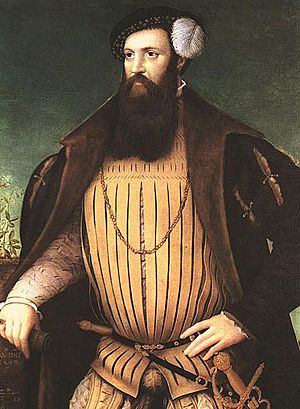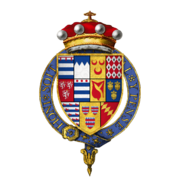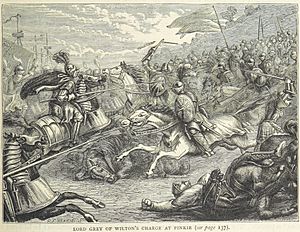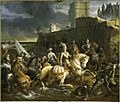William Grey, 13th Baron Grey de Wilton facts for kids
Quick facts for kids
William Grey
|
|
|---|---|
| 13th Baron Grey de Wilton | |

An unknown nobleman, thought to be Lord Grey de Wilton in 1547, by Gerlach Flicke, National Gallery of Scotland
|
|
| Baron Grey de Wilton | |
| Coat of arms |  |
| Tenure | 1520 – 14 December 1562 |
| Predecessor | Richard Grey, 12th Baron Grey de Wilton |
| Successor | Arthur Grey, 14th Baron Grey de Wilton |
| Born | 1508/9 Wilton Castle, Hertfordshire, England |
| Died | 14 December 1562 Cheshunt, Hertfordshire, England |
| Family | Grey |
| Spouse(s) | Lady Mary Somerset of Worcester |
| Issue | Arthur Grey, 14th Baron Grey de Wilton Honora Grey-Denny William Grey |
| Father | Edmund Grey, 9th Baron Grey de Wilton |
| Mother | Florence Hastings |
William Grey, the 13th Baron Grey de Wilton, was an important English nobleman and army leader. He lived from 1508 or 1509 to 1562. He fought in wars in France during the 1540s and 1550s. He also took part in conflicts with Scotland in the 1540s, known as the Scottish Wars.
Contents
Who Was William Grey?
William Grey was the 13th Baron Grey de Wilton. He was the fourth son of Edmund Grey, the 9th Baron Grey de Wilton. His mother was Florence Hastings. William Grey was first called to serve in the English Parliament in 1529. This was during the reign of King Henry VIII of England.
Fighting in France
What Did Grey Do in France (1544-1547)?
During the Italian War of 1542–1546, William Grey was a commander in the English army. This army went to France in 1544. He helped with the attack on Montreuil.
There was some rivalry between Grey and the Earl of Surrey. In 1545, Grey was supposed to lead an army called 'the Crews'. But then it was planned for Surrey to take over this command. Grey was to become the lieutenant of Boulogne.
However, King Henry VIII changed his mind. He ordered Grey to stay in charge of his army. Surrey was sent to Boulogne instead. People at the time noted that there were often attempts to cause problems between these noblemen. Grey eventually replaced Surrey as the leader in Boulogne in April 1546.
During the French fighting, Grey showed great bravery. He was especially known for destroying the Châtillon fortress. He completely tore it down. The King was pleased with Grey and promised him rewards. However, the King died before he could give Grey these rewards.
The Loss of Guînes and Calais (1557-1558)
Grey was appointed governor of the castle of Guisnes in the Pale of Calais. This was an English area in France. When France declared war in 1557, Guînes did not have enough soldiers. Grey warned that he was in danger. Some extra soldiers were sent, but many were not English.
Food also became scarce in Guînes and Calais. On December 1, Grey successfully destroyed a French group. He was known as a fierce leader. He even blew up a church where French soldiers were hiding.
A large French army arrived at Guînes on December 31. Calais was attacked on January 1, 1558. Grey tried hard to save Guînes. He sent urgent messages asking for more soldiers. But Calais fell on January 6.
England quickly gathered 30,000 men to help. They were ordered to go to Dunkirk to save Guînes. But bad weather in the Channel stopped the ships. Guînes was left on its own. Grey, with 1,100 men, burned the town and moved into the castle.
The French army attacked the castle. On the third day, January 19, they tried to storm it. Grey was injured when he accidentally stepped on a sword. His soldiers refused to fight anymore. Grey was forced to surrender.
Grey was held captive until his family paid a large ransom. This cost him a lot of money. He had to sell his old family home, Wilton Castle. In April 1558, Grey was made a knight of the Garter. This was a very important honor.
Military Service in Scotland
The Battle of Pinkie Cleugh (1547)
In 1547, during the reign of King Edward VI, Grey was a field marshal. He was also a captain-general of the horse soldiers. He was sent to Scotland. At the battle of Pinkie Cleugh on September 10, 1547, Grey led the first charge against the enemy.
His son, Arthur, later wrote about Grey's injuries in this battle:
In this battle [Grey] receaved a greate wounde in the mouthe with a pyke, sutche as clave one of his teethe, strake hym thowroghe the tongue, and three fyngers deepe into the rouff of his mouthe: yet notwithstondyng hee poursued owte the chase, wheryn, whot with the aboundance of blood, heate of the weather, and dust of the press, hee had surely been suffocated had not the Duke of Northehumberland, then earle of Warwyck, lyghted and lyfted a fyrcken of ale too hys head, as they passed thowroughe the Scottische camp
—Arthur, Lord Grey, Commentaries
Grey recovered from his severe mouth wound. Twelve days later, on September 22, he was ordered to finish taking Hume Castle. On September 28, he was knighted by Protector Somerset in Berwick.
Protector Somerset returned to England. Grey was left in charge of Berwick. He was also made warden of the east marches and general of the northern areas. On April 18, 1548, Grey and Sir Thomas Palmer crossed the border again. They went to Haddington, which they captured and strongly fortified.
After six weeks of improving the defenses, they left 2,500 soldiers there. They then left, burning Dalkeith and destroying the land around Edinburgh. They slowly returned to Berwick.
"The Commotion Time" (1549)
In the summer of 1549, there were many protests and uprisings across England. This time was called "the commotion time." In July 1549, Grey was sent with 1,500 soldiers to Oxfordshire. He quickly restored order there. He was quite strict with the priests involved.
He then marched to the West Country. He joined the Earl of Bedford. Grey helped a lot in calming down Devon and Cornwall during the Prayer Book Rebellion.
The Siege of Leith (1560)
In December 1559, Grey became the governor of Berwick. He was also the warden of the middle marches towards Scotland. After the Treaty of Berwick was signed, he became the general of the English army. This army was sent to help the Scots against the French.
On March 28, 1560, Grey crossed the river Tweed with 6,000 foot soldiers and 2,000 horsemen. He moved slowly. On April 4, the Protestant lords of the congregation joined him. Grey was annoyed that their soldiers were only hired for twenty days, and twelve days had already passed.
He found Leith too strong to attack without more soldiers. He suggested using the Scottish force to capture Edinburgh Castle. The queen-regent was hiding there. But the Scots were not very enthusiastic. Grey asked Thomas Howard, 4th Duke of Norfolk for advice. Howard did not approve of taking the castle without Queen Elizabeth's knowledge. The Queen also told Grey not to do it.
Fighting began at Leith. But it was stopped by a truce. This was to give Howard time to get instructions from London. Grey was angry about having to wait. After talks with the Scottish lords, the peace plans failed.
The siege of Leith began again. On April 30, a third of the town was destroyed by fire. But there were complaints that Grey was too slow. The blockade failed. Grey decided to take the town by storm. This attack happened on May 7.
The attack was pushed back with heavy losses. Many officers and 800 men were killed or wounded. Grey held his ground, hoping for help to arrive. A leader named Cecil wrote that Grey was a "noble, valiant, painful, and careful gentleman." But his failure was clear.
New talks began, and a treaty was signed in Edinburgh. Peace was announced in Leith on Sunday, July 7. Grey remained governor of Berwick and warden of both marches. He held these positions until he died.
Later Life and Death
In December 1560, Grey welcomed Scottish ambassadors to Berwick. He gave the Earl of Morton a tour of the new forts. Grey stopped his active military command in 1561. He left Berwick and went south.
He died in Cheshunt, Hertfordshire, on December 14, 1562. He was at the home of his daughter and son-in-law, Henry Denny. He was buried in the local church.
Family
Around 1535, William Grey married Lady Mary Somerset of Worcester. She was the daughter of Charles Somerset, 1st Earl of Worcester. They had three children:
- Arthur Grey, 14th Baron Grey de Wilton (1536–1593): He married Dorothy la Zouche first. Then he married Jane Morrison.
- Honora Grey (1540 - 1569): She married Henry Denny. Their son was Edward Denny, 1st Earl of Norwich.
- William Grey: He married Rebecca Shaw. They had a son named Richard Grey.
Images for kids



